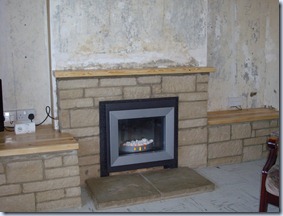Two completely different and unrelated events dominate our lives at this juncture. One concerns our son Ben, whose band’s first single “Little Love” has just been released and is available to buy on the Internet. After talking to him, any understanding we thought we had of the world of the modern music industry has been revealed as hopelessly inadequate. But this does not prevent us from appreciating the effort and skill that has gone into the performing and actually we love the music; it is played here over and over again. Success or failure of the enterprise that Bang Bang Romeo represents now rests upon the readers of this blog buying the music, or so I am led to believe. Just follow this link – SPOTIFY
The second event is a little closer to home. It concerns our living room and the stone monstrosity that we have made into something we like and can admire. At one point only a few weeks ago we came close to demolishing the whole structure, in fact the only thing that stopped us was the risk that in doing so we might create far more work for ourselves than by leaving it in place.
Investigation soon revealed that the massively built structure was only loosely attached to the wall behind; the reality is that it was little more than a folly. So began the job of changing this into something a little more functional which would not fall on top of and maim our first visitors. This has involved taking a risk and following a vision locked somewhere inside our heads, for better or worse, and now that it is complete, even alongside the bare walls in the rest of the room (which we cannot decorate until our builders have finished remodelling the rest of the room) we feel we have created something better than before. We are quite proud of our handiwork and also in some way surprised that we should feel this way. Perhaps this is because making things was not a part of either of our working careers so we are discovering for ourselves the sense of achievement that working with our hands can bring.Outside the house autumn is beginning to show off in the Somerset countryside and there is much to admire just a short walk away. Not only do we live conveniently close to what we need for our DIY – we have no less than four plumbing suppliers within a quarter mile radius and our corner of Yeovil also happens to be the Mecca for screws – but a short stroll from the front door takes us into another world, a valley where the river Yeo trickles softly by and nature is busy producing its bounty – berries in all shades. Alongside this the landscape is gradually tinting from green to the reds and browns of autumn and a leaf carpet is beginning to form. We have discovered a little wonderland on our doorstep, somewhere we plan to visit regularly to watch the seasons develop.












